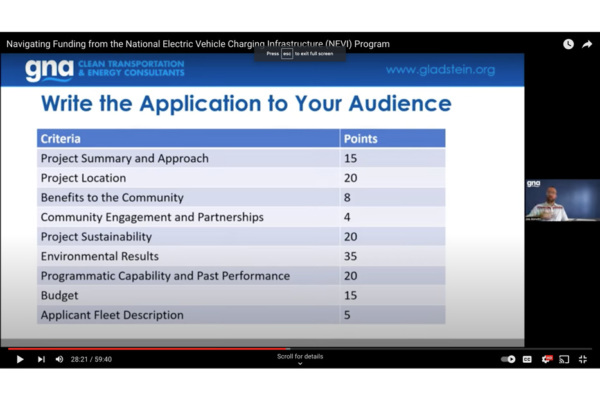Federal and local incentives are available for electric vehicle charging stations, compressed natural gas, propane and hydrogen, and truckstop and travel plaza operators can take advantage of the opportunities that exist.
During a recent NATSO webinar on Navigating Funding from the National Electric Vehicle Charging Infrastructure (NEVI) Program, Joe Annotti, senior vice president and partner with GNA, sat down with NATSO to discuss how operators can prepare and apply for grants.
“Funding is surging right now,” Annotti said, adding that there is $1.2 trillion from the Infrastructure and Investment Jobs Act that has a clean technology focus.
There is $1 billion available through the National Electric Vehicle Charging Infrastructure program that is available for charging funds annually for the next five years.
The clean transportation market right now is $3 billion and is expected to increase in the next few years to $20 billion, with the money coming through several sources. Federal and state governments are the primary sources, followed by cities, air districts and the $3 billion V.W. settlement. In larger states, there are regional, municipal and district funding opportunities.
Some states are investing heavily in EVs, including California, which has added $1 billion for clean fuels and vehicles. Plus, about $750 million has been authorized by California utilities for fleet support through 2025.
Annotti said there have been huge volumes of incentives across the south, which is new. “Texas has already had natural gas funding but is diversifying into the electrification space,” he said, adding that programs are popping up in Louisiana, Florida and the Northeast.
NEVI Funding
NEVI funding takes a carveout and allocates money to clean transportation corridors in each state. “By logic, states with more highways would get more money,” Annotti said.
Texas has $407 million, California has $320 million, but even the smallest state gets $13 million to put towards EV infrastructure. "These states have come up with their own state plans on how to roll out the funding.”
Louisiana, for example, is looking for partnerships with its utilities to support EV charging stations. California has bifurcated its funding, with some going to light duty and a large chunk going to medium- and heavy-duty charging.
One of the critical issues is public access. “In the medium and heavy-duty space, public access may not be a regular strategy for larger fleets. They may want a private facility to mitigate the risk,” Annotti said. “There will be an interesting play on how that shakes out because of the way public access is required.”
Growth in ESG
Adoption of EVs is growing as companies work to increase their environment, social and governance (ESG) efforts. Annotti said several large corporations, including U.S. Foods, Cisco and Schneider, have announced commitments to reduce emissions. “It is great to see the market being propelled forward by its own stakeholders,” he said.
Regulatory Requirements
Regulations are also driving EVs and alternative fuel vehicles forward. The Advanced Clean Trucks Rule sets a minimum sales goal for zero-emission trucks. In states that have adopted the Advanced Clean Trucks Rule, truck makers must sell a minimum number of electric trucks in the state as of the reporting date. “Otherwise, it has to buy offset credits, or it is punished and has to lower its diesel sales volumes. The end of 10-year adoption is the end of 2035 in most states,” Annotti said.
There is also the Advanced Clean Fleets Rule, which is still in the rulemaking process. Once that rule is adopted, fleets will be required to purchase an increasing percentage of zero-emission trucks each year. "OEMs will be regulated first, but fleets will be right behind it. There is an aggressive parallel path, and this speaks to some of the regulatory drivers moving this forward,” Annotti said.
Fifteen states and the District of Columbia have signed a memorandum of understanding for zero-emission vehicles to reach 30% of sales by 2030 across all vehicle classes.
Successful Applications
Funding applications for EV charging infrastructure can take a myriad of forms depending on each state's grant program and priorities, and every funding program will be different. However, several strategies can help operators secure funding. "When you approach a grant application, ultimately you have to get the application in before the deadline or, if it is first-come, first-serve, you have to get it in as soon as possible,” Annotti said.
There is almost always a narrative portion of the application. “It isn’t necessarily the story you want to tell. It is the story the funding organization wants to hear,” Annotti said. “If it doesn't match what the funding agency needs to hear in terms of their scoring criteria and rubric, you won't score the points, and likely won't win.”
For projects that are looking to replace existing diesel or gasoline vehicles or deploy new alternative fuel vehicles, applicants are typically asked to describe the fleet, including vehicles, domicile, mileage and fuel consumption. The next component is to discuss emissions.
“These grants at their core are a purchase of air quality,” Annotti said. “As part of that, you need to justify why your project is actually going to reduce emissions.”
Numerous calculators can help fleets quantify emissions, including the EPA's diesel emissions quantifier and a tool from the National Renewable Energy Laboratory. “At the end of the day, it is going to come down to the amount of investment—the dollars from the funding agency—in return or exchange for how many emissions reductions you’re going to give them in return for that investment,” Annotti said.
There are also administrative forms, and applicants need to be sure they're checking the right boxes to obtain points. “You need to make it as simple as possible for them to understand what you’re proposing and to score your application,” Annotti said.
Additionally, partnership letters are critical to showing organizations' support. Annotti urged companies to include non-profits in their plans.
“I can’t stress enough how important these non-profits and non-government organizations are to projects. We’ve seen applications make or break because a non-profit stood in the way,” he said. “If they’re not on your side, they are against you. It is a really good strategy to engage with them to have them understand what you’re up to and show their support.”
// The July 21, 2022 webinar was provided by NATSO’s Campaign for Economically and Environmentally Sustainable Travel Centers. NATSO and The NATSO Foundations Campaigns for Economically and Environmentally Sustainable Travel Centers are generously sponsored by:


NATSO’s EV Charging Funding Opportunities Digital Toolkit
This spring, NATSO launched its newest online resource: “EV Charging Funding Opportunities.” The digital toolkit is provided by NATSO’s Campaign for Economically and Environmentally Sustainable Travel Centers.
Here NATSO members can find answers to frequently asked questions as well as information on how to:
- Secure funding;
- Connect with our charging provider partners;
- Participate in the National Highway Charging Collaborative, and
- Join the Charge Ahead Partnership.
There are also documents that link to additional NATSO resources including EV Charging podcasts, articles and webinars, including "The Business Case for EV Charging at Retail."
Subscribe to Updates
NATSO provides a breadth of information created to strengthen travel plazas’ ability to meet the needs of the travelling public in an age of disruption. This includes knowledge filled blog posts, articles and publications. If you would like to receive a digest of blog post and articles directly in your inbox, please provide your name, email and the frequency of the updates you want to receive the email digest.



